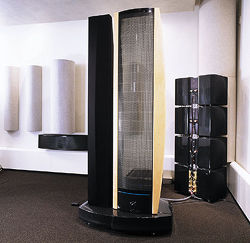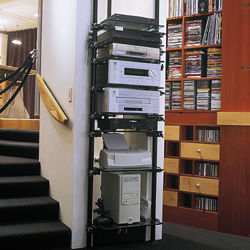Home Theater On the Plains Page 2
 Time and resources won't allow us to audition, in person, all of the systems we'll ultimately feature in this section, but in this case I did get to make the trek to Kansas. The first thing Sanders played for me was music, which amply
demonstrated the capabilities of the Statements. They will play
exceptionally loud—far louder, even in this very large room, than I
or most listeners would ever want to listen—with unmistakable
immediacy and presence. But they also have the spacious, detailed
quality craved by lovers of electrostatics.
Time and resources won't allow us to audition, in person, all of the systems we'll ultimately feature in this section, but in this case I did get to make the trek to Kansas. The first thing Sanders played for me was music, which amply
demonstrated the capabilities of the Statements. They will play
exceptionally loud—far louder, even in this very large room, than I
or most listeners would ever want to listen—with unmistakable
immediacy and presence. But they also have the spacious, detailed
quality craved by lovers of electrostatics.
The sound was exceptional in all respects. Aside from the obvious strengths of electrostatics in general, the system continued to play louder, without obvious distress, than any electrostatic system in my experience. No polite, dynamically limited sound here. And while I felt that the smallish Logos center was perhaps a little overwhelmed by its hulking neighbors to the east and west, I have to admit that much of this impression was visual-the Statements simply dwarf the little Logos. I heard nothing obviously amiss in the blending of the left, center, and right signals—or in the rest of the system, for that matter.
But I was perhaps most strongly impressed by the subwoofers. Sixteen 12-inch drivers move a lot of air! Even Sanders was surprised by what he heard from Soldier, one of the DVDs I'd brought along. The bass from this disc, as heard on the Statement subs, was truly frightening. I had never heard another sub that could approach them at the time, nor have I since.
 The large room certainly helped, providing plenty of room for the
system to breathe. The more-rigid-than-usual walls also likely
provided assistance in supporting the bass. While such rigid walls
are often less than desirable—the slight flexure of regular Sheetrock
provides some bass absorption, which can lessen the magnitude of
standing waves—I can't argue with the result here.
The large room certainly helped, providing plenty of room for the
system to breathe. The more-rigid-than-usual walls also likely
provided assistance in supporting the bass. While such rigid walls
are often less than desirable—the slight flexure of regular Sheetrock
provides some bass absorption, which can lessen the magnitude of
standing waves—I can't argue with the result here.
The only thing I neglected to do was get up and walk around the room to check for bass consistency-the bugaboo of most enclosed domestic spaces. But from where I sat, the bass was not boomy, just awesomely deep and powerful. Unfortunately for those who can't afford the entire Statement system, the subs are not available separately. Martin Logan has since designed and marketed a whole line of impressive subwoofers, but even the best of them (the top-of-the-line Descent, a review of which may be found elsewhere on this website) is much less ambitious than the Statement subs.
I also noted that, despite the huge bass pressures generated by the system, there were no obvious rattles in the room. While a sweep test (which we did not do) might have excited a buzz here or there, the bass-rich program material we listened to did not.
The system's video side, while not quite up to the state-of-the-art level of the sound, was still nothing to sneeze at. The room's white walls were not the best choice for squeezing the best contrast ratio from a projector, but I saw no obvious image degradation from this.
 Nor did I spot any problems with the perforated screen—a relatively high-gain (1.8)
Stewart Videomatte 200. But the screen's perforations are largely
unneeded with the center-channel mounted below it; while replacing it
with a non-perf, lower-gain version might further improve the image,
it might also have sonic consequences. A perforated screen allows at
least some of the wall reflections generated by the rear of the front
dipole speakers to pass through it (note that the screen is mounted
well forward of the room's front wall); a solid screen would block
some of these reflections, possibly degrading the sound.
Nor did I spot any problems with the perforated screen—a relatively high-gain (1.8)
Stewart Videomatte 200. But the screen's perforations are largely
unneeded with the center-channel mounted below it; while replacing it
with a non-perf, lower-gain version might further improve the image,
it might also have sonic consequences. A perforated screen allows at
least some of the wall reflections generated by the rear of the front
dipole speakers to pass through it (note that the screen is mounted
well forward of the room's front wall); a solid screen would block
some of these reflections, possibly degrading the sound.
Overall, this home theater was outstanding. But just as I was pondering how I might arrange to hang around for a few days to watch, oh, maybe 15 or 20 movies, the audition came to an abrupt halt. I was adjusting the volume with the touchscreen remote control when I accidentally pushed System Off. As I scrambled in vain to find some sort of Delete Command button, the audio and video shut down, the lights came up, the screen retracted, and the room drapes opened! Sanders admitted that the remote programming was still being refined. Even the most impressive system, it seems, can always be improved.
- Log in or register to post comments




































































